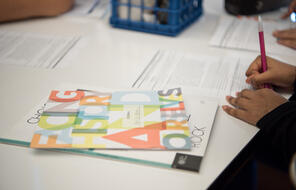In this exercise, students will identify evidence that is relevant to prove a particular claim. This activity is most effective if students have a basic command of the concept of relevance. Therefore, we suggest modelling this process with a few examples. We recommend that you start with a real-world example and then test students’ understanding in a literature-based example
Example 1: Real-World Claim: Mobile phones should not be allowed in school.
- Which of the following pieces of evidence are relevant and support this claim?
- Which of the following pieces of evidence are not relevant to this claim?
- (a) Mobile phones distract from the learning environment. Students who text or play games on their phones during class do not hear directions or miss learning important content.
- (b) Many students today bring mobile phones to school.
- (c) Mobile phones are more affordable now than they were in 2000.
- (d) In surveys, some students report using their mobile phones to cheat in exams.
Here are some ideas to bring up during a discussion of this question:
- (a) and (d) are both relevant to defending the claim.
- (b) provides accurate information but is irrelevant to proving the claim.
- (c) may or may not be accurate. It is also irrelevant to proving the claim.
Example 2: Literature-based Claim: Priestley presents the character of Mr Birling in An Inspector Calls as ignorant and out of touch.
- Which of the following pieces of evidence are relevant and support this claim?
- Which of the following pieces of evidence are not relevant to this claim?
- (a) The Crofts are not celebrating the engagement dinner with the Birlings.
- (b) Birling is looking forward to a time when Crofts and Birlings ‘are working together – for lower costs and higher prices’.
- (c) Birling believes that there ‘isn’t a chance of war’.
- (d) Birling speaks more than anyone else in the opening scene.
Here are some ideas that you might bring up during a discussion of this question:
- While (a) may be correct, it is not relevant to supporting the claim about Mr Birling.
- (b) could be used: it suggests Mr Birling is out of touch, but it does not suggest he is ignorant.
- (c) is relevant evidence: it highlights how Birling is out of touch because he states that war is not going to happen, but the audience knows that not only did the First World War begin two years later, but that the Second World War broke out less than thirty years later. The dramatic irony makes Birling seem ignorant and out of touch with reality.
- (d) highlights Birling’s self-involved nature and the fact that he may be out of touch with the social situation, but not his ignorance.



















